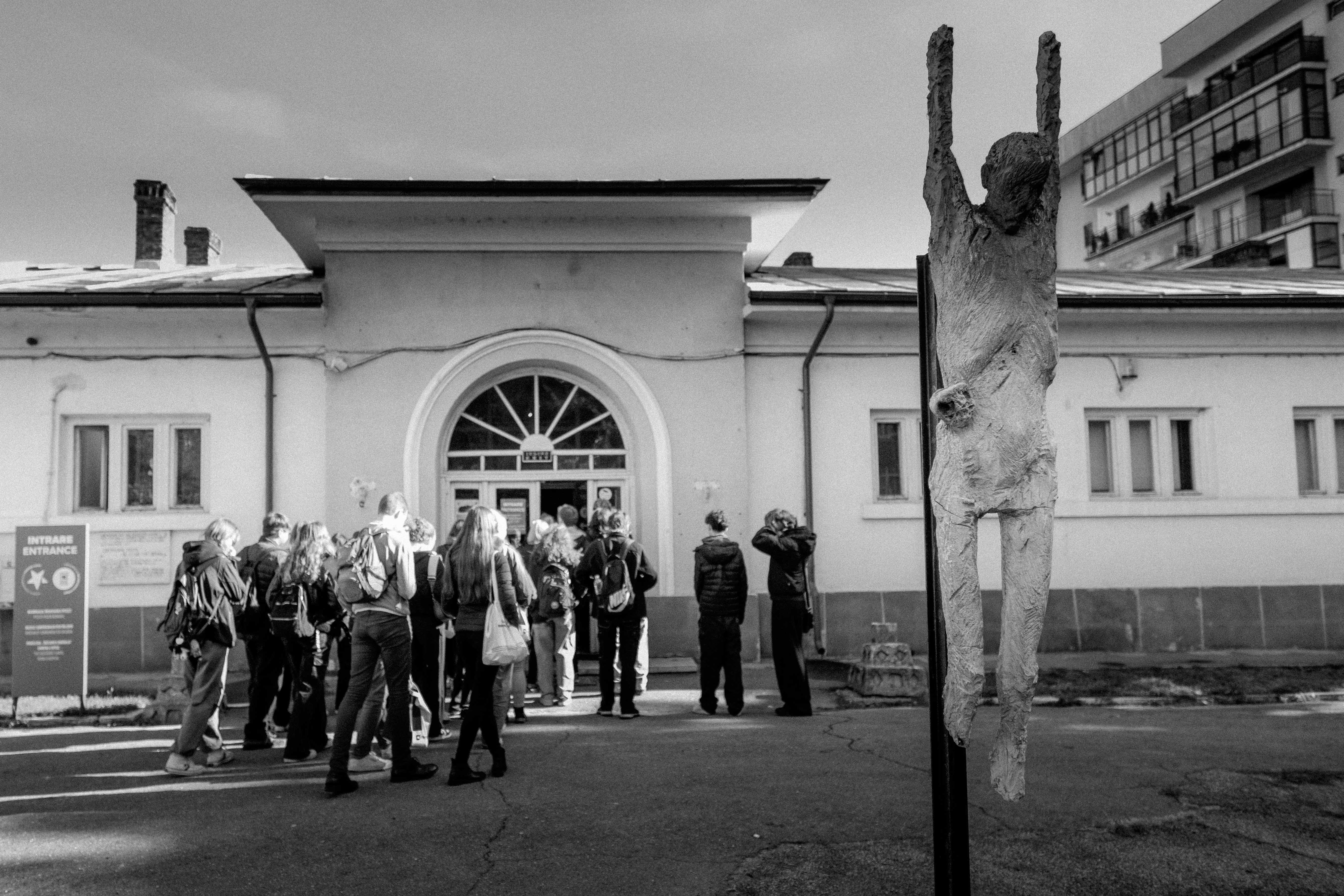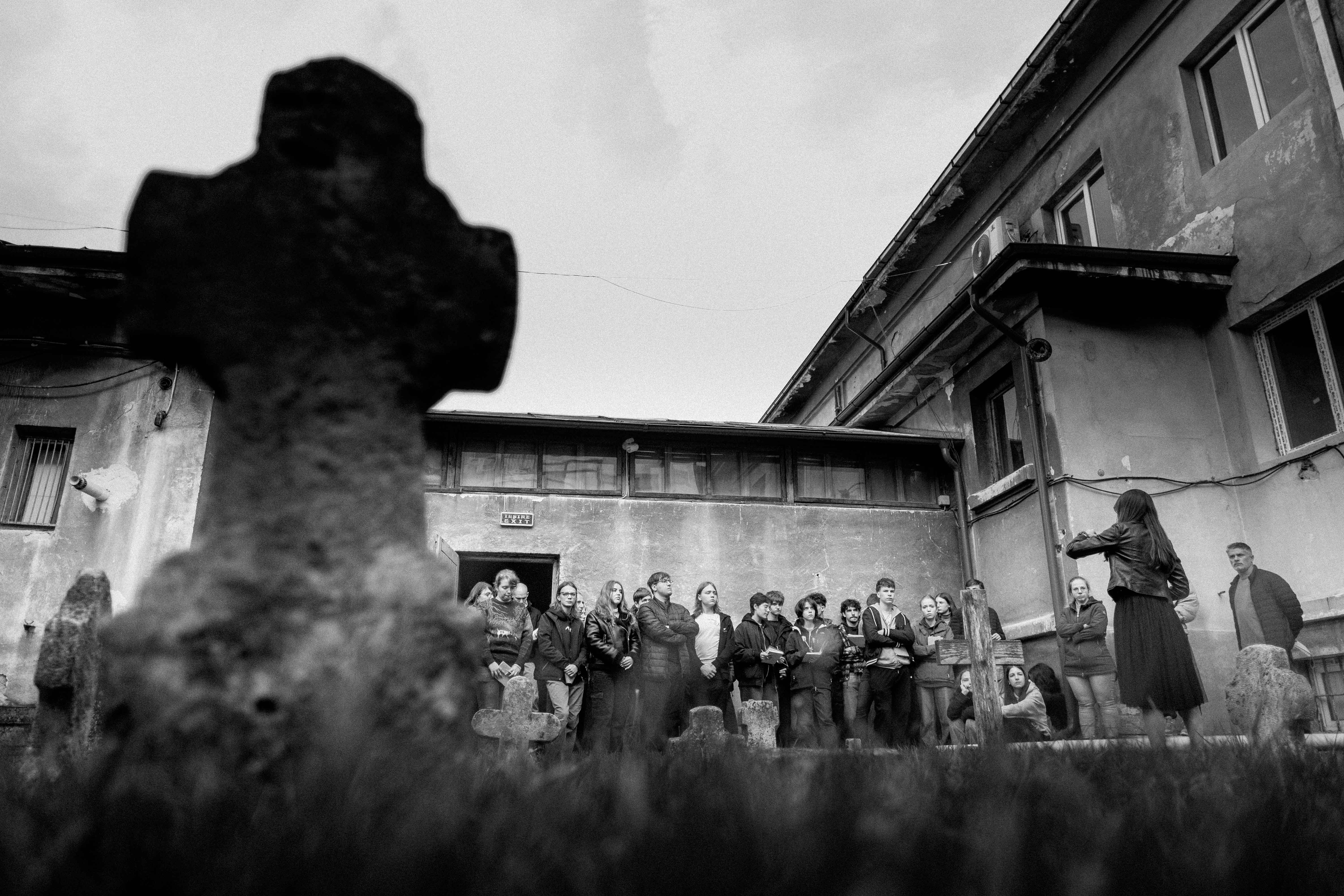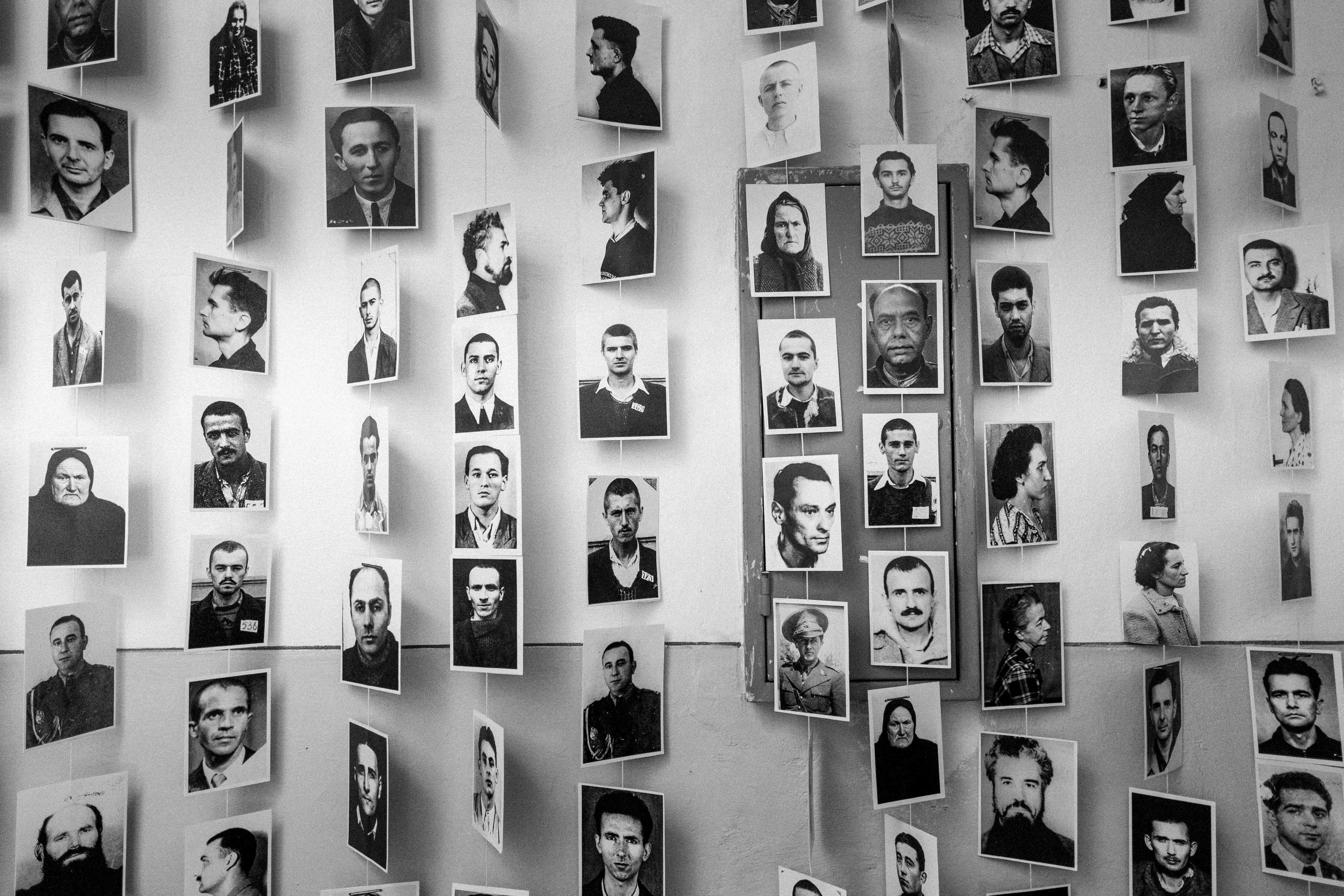Interview With Maria Axinte Creator of the Children’s Museum of Communism by Kristina Tamelytė correspondent for LRT.lt
‘Abolishing a museum, in my view, brings little value. What truly matters is fostering dialogue about it and the complex choices people have had to face,’ says Maria Axinte, a Romanian and co-founder of the Children’s Museum of Communism in Romania. When asked about the controversy surrounding the Venclova House Museum in Vilnius, which relates to poets who served the Communist Party, she emphasises the necessity of confronting painful experiences and understanding them, as only through such engagement can the wounds of society begin to heal.
I had the opportunity to speak with Maria in Warsaw during the European Remembrance Symposium, an event organised by the ENRS. This symposium brought together museum professionals, historians and policymakers to explore the concept of freedom and its significance in the modern world.
Maria Axinte came to Warsaw to share her experience of creating the Children’s Museum of Communism in Romania. We talked not only about the origins of this ambitious initiative but also about the methods employed by the museum’s educators to engage children and convey the historical context of Romania’s communist past. Her reflections offered a compelling glimpse into the delicate balance of presenting difficult histories to young audiences while fostering understanding and critical thinking.
You are one of the authors of the Museum of Communism for Children. How did the idea of creating such a museum come about?
MA: I must say that this idea was not part of our initial plan, nor did we foresee bringing it to fruition. I represent the Pitești Prison Memorial Museum, a site located in southern Romania, near Bucharest. This prison operated during the years 1949–51, when Romania was under the rule of the Communist Party. It was a place where both physical and psychological violence were used to ‘re-educate’ young, politically active people who did not share communist views at the time (about 600 young people were imprisoned there – LRT.lt). The aim was to convert them to communism. This period stands out as one of the most brutal chapters in both the history of communism and Romania.
The exhibition at the Memorial Museum is not accessible to children, as the emotions, experiences and events it portrays are simply too intense. You have to be at least 12 years old to visit the museum. We believe that by this age, a child is capable of beginning to understand the more complex and painful aspects of the world.
However, while working on the exhibition, we realised that children often came with their parents to our location but because of their age were unable to visit the prison exhibition. We were often asked by the children why they could not see the exhibition.
Our encounter with a Romanian artist who creates illustrations about children in prisons inspired the idea for a new exhibition. However, we couldn’t simply focus on repression alone – we needed to provide children with context. What is communism? Why did communists imprison people? Had these individuals done anything wrong?
Together with the previously mentioned artist, we created a graphic novel depicting the imprisonment of children in Romania. This was followed by an exhibition about communism tailored for children. Over time, we realised that we could expand this initiative into a fully fledged museum, where children could gain a deeper understanding of that era and see the world from the perspective of children who lived under communism.
Today, the Children’s Museum of Communism comprises four exhibition spaces, and we plan to add two more, as we have recently received additional funding for the project.
What can young visitors discover in your exhibition?
MA: First and foremost, children can learn about the ideological foundations of communism. We discuss figures such as Karl Marx and Friedrich Engels. Notably, communism was banned in Romania before 1944, but following the arrival of the Soviet army, all political prisoners were released from jail.
The presence of the Soviet army on Romanian soil naturally facilitated the Communist Party’s rise to power. In the 1946 elections, votes were blatantly falsified.
To illustrate this historical manipulation, we’ve designed an educational exercise for children. During the activity, they’re invited to vote on how they would like to conduct their lesson that day: either in a traditional, school-like format or in an interactive way. The voting process is conducted in secret, and once the votes are tallied, we announce that the traditional method has won – regardless of the actual results. Most children are visibly dissatisfied, having voted for the interactive option. At this point, we ask them how they feel about such an outcome. Of course, they’re unhappy – they didn’t vote for it! Eventually, the activity proceeds in the interactive format they originally chose, but the exercise allows them to experience the injustice of manipulated elections firsthand. We then discuss how people might feel in the face of such falsifications, as happened during Romania’s communist era.
The exhibition also introduces children to various methods of repression used under communism, such as collectivisation, nationalisation and political imprisonment. These lessons aim to foster a deeper understanding of the mechanisms of control and their impact on individuals and society.
We strive to emphasise resistance, particularly the fact that children also took part in various forms of resistance against the Soviet regime. For instance, some children also were born into partisan groups in the mountains, while others were born to imprisoned mothers and spent the first years of their lives in prison or were themselves detained in children’s prisons.
In the new sections of the exhibition, we aim to address topics such as the revolution, the fall of the communist regime and the emergence of democracy, effectively guiding children towards the present day. This part of the exhibition is still under development.
An essential element of our approach is to allow children to engage with the exhibits physically. For example, we feature biographies of former communist leaders of Romania, Gheorghe Gheorghiu-Dej and Nicolae Ceaușescu. Children are prompted to place these biographies in metal cabinets, symbolising the imprisonment of many Romanian citizens by these leaders without just cause. Through this metaphor, we ‘imprison’ the leaders themselves in the cabinets. Children are then invited to release them and learn more about their lives and actions.
I believe this metaphor is both powerful and engaging. Some children are hesitant – even frightened – and refuse to open the cabinets, while others find the activity fascinating. It offers them an opportunity to learn not only about historical figures but also about themselves and their responses to such symbolic acts.
When we launched the museum, we also introduced a diary-like learning tool called My Communist History Journal. This chronicle of Romania’s communist era is written in accessible, child-friendly language. It features various exercises, encouraging children to become detectives of history.
We avoid overwhelming them with intricate details or facts about communism. Instead, we aim to spark conversations with their families and peers. For example, one task asks children to assume the role of a journalist and interview their parents about their experiences and perceptions of communism. They’re encouraged to ask what their parents know about resistance to the regime.
Of course, the exhibition also touches on the experiences of children imprisoned in places like Pitești Prison. We invite young visitors to reflect on the hardships these children endured, such as being deprived of sleep, being under constant supervision and enduring regular physical abuse. We ask them to imagine: What do you think went through the minds of these children when they couldn’t sleep?
It seems that you aim to emphasise children’s active participation in the learning process, encouraging them to experience it rather than simply receiving information. Could you elaborate on how you present the ideology of communism? You mentioned Karl Marx is part of the exhibition.
MA: We are talking about children who often have no prior knowledge of communism, as the Romanian education system does not address the subject comprehensively or systematically.
We start by explaining that communist ideology sought to unite everyone through revolution, but within this vision lay a deep animosity towards a specific class coupled with the desire to make all people uniform and equal. Rather than focusing on the authors themselves, we present the core ideas. I believe this raises broader questions about what it means to be different and how one can live with that difference. We aim to incorporate a civic dimension into the exhibition, which is why we also discuss children’s rights. For example, we remind them that their parents had to attend school on Saturdays, perform certain tasks for the state – such as picking grapes and harvesting vegetables – and sing songs praising the president’s greatness. We then ask the children: Would you agree to such conditions? How would you feel if you had to live the way your parents or grandparents did?
In Romania, there isn’t much emphasis on civic education, and we want to fill this gap. We hope both parents and teachers will place greater importance on nurturing civic awareness. Civic education is not merely a subject in school – it’s about preparing children for life, for their role in society and even defending themselves when necessary. It’s about ensuring they are ready to navigate the challenges of the world.
Some might argue that discussing such complex and painful periods is unnecessary, especially with children. How would you respond to such remarks?
MA: I offer this analogy: hiding an infected wound only makes the situation worse. The wound needs to be cleaned and treated; only then can healing begin. The process will undoubtedly be painful – touching an infected, festering wound always hurts. But eventually, it will heal, leaving a scar that may even be smaller if treated in time.
Waiting for the wound to turn gangrenous, to the point where an arm or leg must be amputated, is hardly a wise course of action. So much time has passed since communist regimes in Europe collapsed, and yet we have barely begun to address this history openly.
I believe many of the deep traumas and challenges faced by our societies today stem from unresolved issues of the past. In Romania, there is much pride in the country’s liberation from communist rule, but also a lingering sense of guilt for not having done more as a society. We stood by and watched as our neighbours were oppressed, tortured and imprisoned. Even now, we often refuse to discuss these experiences openly. We still refuse to talk about it. If we were to truly confront this history, we would also have to face our own uncomfortable feelings and fears. These unresolved emotions fester if left unspoken. Without addressing them, we cannot move forwards. Open dialogue, however painful, is the only path towards genuine healing and progress.
What reactions have you received from the public and the children who visit the museum?
MA: We haven’t encountered any negative reactions, which suggests that society is now more prepared for such an initiative and, in some ways, already familiar with our work.
What surprised me most were the reactions of the children – they knew more than we had expected. Of course, before creating the museum, we conducted various activities and focus groups with children, involving about 3,000 participants. This gave us some insight into what children think, but they still managed to surprise us.
Interestingly, we realised that it’s not only children but also adults who often don’t really know what communism as an ideology was. In fact, when we began working on the museum, we often encountered the phrase, ‘Communism was a great idea, but it was poorly implemented in practice.’ From my perspective, that’s simply not true. This idea was never good to begin with. Perhaps we are inclined to believe in the ideals of communism because, in reality, we don’t know much about them. That’s precisely why we wanted to address this in our museum – to provide a space for reflection and understanding about the true nature of communism and its impact.
Romania and Lithuania share some similar historical experiences. In Lithuania, there is currently much debate about the past, with ongoing disputes regarding the memory of Lithuanian figures who served the Communist Party. For example, Antanas Venclova was a poet and literary critic, but also a political figure. In Vilnius, there is still a museum dedicated not only to him but also to his son, Tomas Venclova – a poet, dissident and exile from the USSR to the United States. The museum is located in their former home, which also carries interwar history. As a professional in the museum field, how would you approach such a museum?
MA: Today, cancel culture has gained popularity, but it’s something I personally reject. It erases certain moments from history. If we want to critically engage with history, we must first understand it. Without knowledge, and by selectively focusing only on aspects that seem worth discussing, we are not dealing with true history.
We face a similar situation in Romania regarding a poet who was favourable to the regime and his associated museum. It’s essential to recognise these individuals, to understand their actions and choices. Regarding the family you mentioned, we can address the different dimensions of their lives. Every individual is a person with a history, a family and the capacity to love their children. At the same time, we must also highlight their misdeeds and moral failings. I don’t believe abolishing a museum is a valuable solution. Far more important is fostering dialogue about it and the complex choices people had to make.
It seems to me that this lesson is powerfully reflected in the phenomenon of Pitești Prison: you never truly know who you are or how you might act until you find yourself in a difficult situation. In such moments, you see yourself stripped of embellishments, and what you discover may not always be pleasant. After all, in Pitești Prison, individuals who were once friends turned on each other. These were remarkable people, and even after enduring the horrors of this brutal experimental prison, they went on to lead lives without harming others. Yet, their actions within the prison cannot be erased from their past. At the Pitești Prison Museum, we pursue a similar mission: to show that the conditions these people faced were fundamentally unjust, regardless of who they were.
This interview was first published on the portal www.lrt.lt on 16 June 2024: Komunizmo muziejaus vaikams kūrėja: pūliuojančios žaizdos slėpimas tik pablogina situaciją



